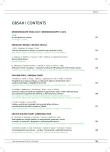Retrospective Study of Magnetic Resonance Imaging of the Brain and Spine in Neuromyelitis Optica
Authors:
M. Vaněčková 1; D. Horáková 2
; E. Havrdová 2; P. Nytrová 2; J. Němcová 3; Z. Seidl 1,3
Authors‘ workplace:
Oddělení MR, Radiodiagnostická klinika 1. LF UK a VFN v Praze
1; Neurologická klinika 1. LF UK a VFN v Praze
2; Vysoká škola zdravotnická, o. p. s., Praha
3
Published in:
Cesk Slov Neurol N 2010; 73/106(2): 164-168
Category:
Short Communication
Overview
Objectives:
A retrospective MRI study of rare demyelinating disease – neuromyelitis optica (NMO). Monitoring differences in multiple sclerosis are addressed as a diagnostic issue.
Patients and methods:
A cohort of 8 patients with a diagnosis of NMO (7 satisfying the 2006 Wingerchuk criteria, one with lupus erythematodes, high risk, all of them NMO‑IgG seropositive) was evaluated by means of MRI. Patients were considered in terms of four groups: MS‑like, atypical, nonspecific and with normal brain imaging. MRI findings were evaluated on initial and repeated examinations.
Results:
4 patients had a spinal cord lesion extending over more than 3 segments, 3 in the cervical spine, with typical signal intensity. Pathological MRI brain findings were found in 2 patients on initial examination and in 5 patients in the course of repeated examinations (lesion in medulla prevailed). MS‑like lesions, however not satisfying the Barkhof criteria, were found in 2 patients. One patient had negative MRI brain and spine findings.
Conclusions:
Brain MRI findings are not always negative for NMO disease. There are even localizations typical of it (lesion in lower medulla in continuity with the cervical cord). If MRI findings for NMO patients are similar to MS findings, Barkhof criteria are not usually satisfied. MRI findings in the spine depend on correct timing with acute myelitis; this may be a reason for non‑satisfaction of the size criterion for intramedullar lesion.
Key words:
neuromyelitis optica – magnetic resonance imaging – diagnostic
Sources
1. Argyriou AA, Makris N. Neuromyelitis optica: a distinct demyelinating disease of the central nervous system. Acta Neurol Scand 2008; 118(4): 209–217.
2. Dale RC, Brilot F, Banwell B. Pediatric central nervous system inflammatory demyelination: acute disseminated encephalomyelitis, clinically isolated syndromes, neuromyelitis optica, and multiple sclerosis. Curr Opin Neurol 2009; 22(3): 233–240.
3. Weinshenker BG, Wingerchuk DM, Vukusic S, Linbo L,Pittock SJ, Lucchinetti CF et al. Neuromyelitis optica IgG predicts relapse after longitudinally extensive transverse myelitis. Ann Neurol 2006; 59(3): 566–569.
4. Wingerchuk DM, Weinshenker BG. Neuromyelitis optica: clinical predictors of a relapsing course and survival. Neurology 2003; 60(5): 848–853.
5. Miller DH, Weinshenker BG, Filippi M, Banwell BL, Cohen JA, Freedman MS et al. Differential diagnosis of suspected multiple sclerosis: a consensus approach. Mult Scler 2008; 14(9): 1157–1174.
6. Havrdová E. Roztroušená skleróza. Cesk Slov Neurol N 2008; 71/104(2): 121–132.
7. Vaněčková M, Seidl Z. Roztroušená skleróza mozkomíšní a magnetická rezonance: současnost a nové trendy. Cesk Slov Neurol N 2008; 71/104(6): 664–672.
8. Wingerchuck DM, Hogancamp WF, O’Brien PC, Weinshenker BG. The clinical course of neuromyelitis optica (Devic’s syndrome). Neurology 1999; 53: 1107–1114.
9. Lennon VA, Wingerchuk DM, Kryzer TJ, Pittock SJ, Lucchinetti CF et al. A serum autoantibody marker of neuromyelitis optica: distinction from multiple sclerosis. Lancet 2004; 364(9451): 2106–2112.
10. Waters P, Vincent A. Detection of anti‑aquaporin‑4 antibodies in neuromyelitis optica: current status of the assays. Int MS J 2008; 15(3): 99–105.
11. Wingerchuk DM, Lennon VA, Pittock SJ, Lucchinetti CF, Weinshenker BG. Revised diagnostic criteria for neuromyelitis optica. Neurology 2006; 66(10): 1485–1489.
12. Barkhof F, Filippi M, Miller DH, Scheltens P, Campi A,Polman CH et al. Comparison of MR imaging criteria at first presentation to predict conversion to clinically definite multiple sclerosis. Brain 1997; 120(11): 2059–2069.
13. Polman CH, Reingold SC, Edan G, Filippi M, Hartung HP et al. Diagnostic criteria for multiple sclerosis: 2005 revisions to the “McDonald Criteria”. Ann Neurol 2005; 58(6): 840–846.
14. Miller DH, Weinshenker BG, Filippi M, Banwell BL, Cohen JA et al. Differential diagnosis of suspected multiple sclerosis: a consensus approach. Mult Scler 2008; 14(9): 1157–1174.
15. Goodin DS, Frohman EM, Garmany GP, Halper J, Likosky WH, Lublin FD et al. Disease modifying therapies in multiple sclerosis: report of the Therapeutics and Technology Subcommittee of the American Academy of Neurology and the MS Council for Clinical Practice Guidelines. Neurology 2002; 58(2): 169–178.
16. Pittock SJ, Lennon VA, Krecke K, Wingerchuck DM, Lucchinetti CF et al. Brain abnormalities in neuromyelitis optica. Arch Neurol 2006; 63(3): 390–396.
17. Li Y, Xie P, Lv F, Mu J, Li Q, Yang Q et al. Brain magnetic resonance imaging abnormalites in neuromyelitis optica. Acta Neurol Scand 2008; 118(4): 218–225.
18. Cabrera‑Gómez JA, Quevedo‑Sotolongo L, González‑Quevedo A, Lima S, Real‑González Y, Cristófol‑Corominas M et al. Brain magnetic resonance imaging findings in relapsing neuromyelitis optica. Mult Scler 2007; 13(2): 186–192.
19. Nakamura M, Misu T, Fujihara K, Miyazawa I, Nakshima I, Takahashi T et al. Occurrence of acute large and edematous callosal lesions in neuromyelitis optica. Mult Scler 2009; 15(6): 695–700.
Labels
Paediatric neurology Neurosurgery NeurologyArticle was published in
Czech and Slovak Neurology and Neurosurgery

2010 Issue 2
- Metamizole vs. Tramadol in Postoperative Analgesia
- Metamizole at a Glance and in Practice – Effective Non-Opioid Analgesic for All Ages
- Memantine in Dementia Therapy – Current Findings and Possible Future Applications
- Memantine Eases Daily Life for Patients and Caregivers
- Hope Awakens with Early Diagnosis of Parkinson's Disease Based on Skin Odor
Most read in this issue
- Huntington’s Disease
- Unusual Clinical Picture in Migraine – Case Reports
- Retrospective Study of Magnetic Resonance Imaging of the Brain and Spine in Neuromyelitis Optica
- Neurorehabilitation
